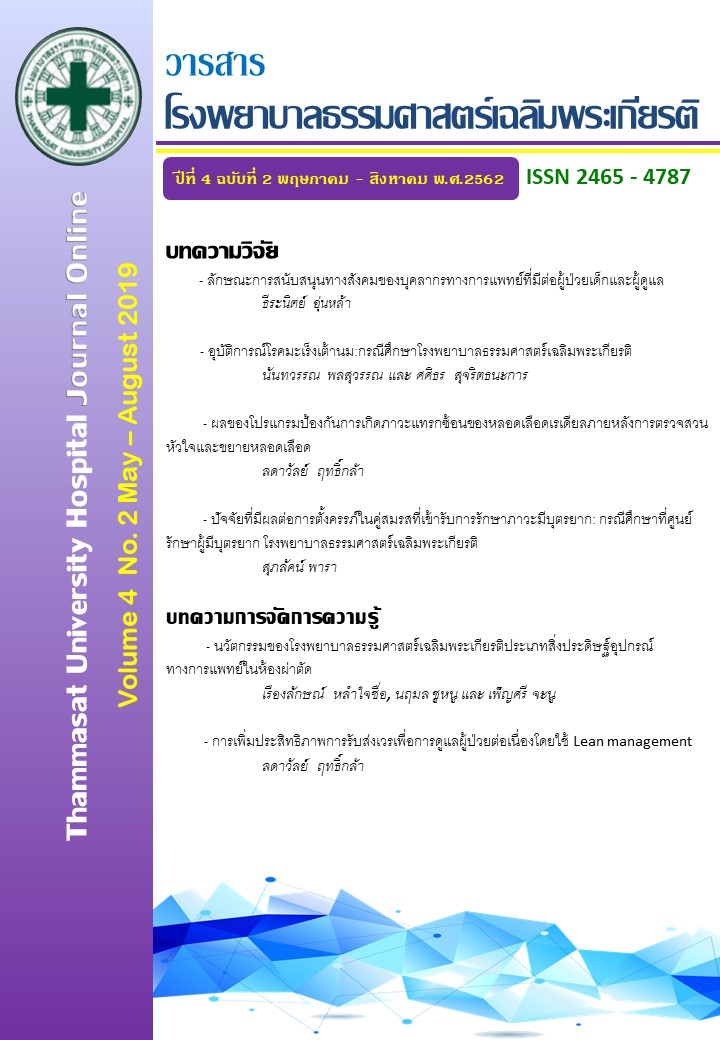Incidence of Breast Cancer: A study in Thammasat University Hospital
Keywords:
Breast cancer, Incidence, treatmentAbstract
Background: The incidence of breast cancer at Thammasat University Hospital is steadily increasing, thus collecting data regarding breast cancer patients including the stage of breast cancer and the type of treatment received could better improve the treatment of future patients.
Objective: To study the incidence of breast cancer and type of treatment at Thammasat University Hospital.
Material and methods: The sample consisted of breast cancer patients who had been treated at Thammasat University Hospital between 2011 and 2016. The data was collected using the Breast record form and was analyzed based on percentage of population.
Result: The results of our study demonstrated that there were 436 new breast cancer patients treated at Thammasat University Hospital within 5 years. Of which, the highest incidence was seen in women 46-50 years of age. The most common breast cancer stage was stage 2 (37.84%), while 18.81% and 9.63% were diagnosed with stage 3 and 4, respectively. Most breast cancer patients (85.55%) received surgical treatment with total mastectomy being the most common surgical procedure performed, followed by breast conserving surgery and breast reconstruction which was 69.04%, 16.51% and 11.47% respectively. Furthermore, the method of sentinel lymph node biopsy (SLNB) was reported to be 38.07%. Patients also received adjuvant treatment for breast cancer including chemotherapy, endocrine therapy and radiation which was reported as 24.70%, 18.27% and 24.19%, respectively.
Conclusion: The development of a caring system for breast cancer patients in Thammasat University Hospital is important especially with an increasing of number of breast cancer patients each year. The most common treatment is surgery which should constantly be improving to reduce complications and improve quality of life of breast cancer in the future.
References
Siegel R, Ma J, Zou Z, Jemal A. Cancer statistics, 2014. CA Cancer J Clin 2014 Jan;64:9-29.
National Cancer Institute. HospitalBased Cancer Registry Annual Report 2010. Bangkok: National Cancer Institute Department of Medical Services Ministry of Public Health, 2011.
National Cancer Institute. Hospital-Based Cancer Registry Annual Report 2013. Bangkok: National Cancer Institute Department of Medical Services Ministry of Public Health, 2015.
Leong SP, Shen ZZ, Liu TJ, Agarwal G, Tajima T, Paik NS, Sandelin K, Derossis A, Cody H, Foulkes WD. Is breast cancer the same disease in Asian and Western countries? World J Surg 2010 Oct;34:2308-24.
Ferlay J, Soerjomataram I, Dikshit R, Eser S, Mathers C, Rebelo M, Parkin DM, Forman D, Bray F. Cancer incidence and mortality worldwide: sources, methods and major patterns in GLOBOCAN 2012. Int J Cancer 2015 Mar;136:E359-86.
ภรณี เหล่าอิทธิ, นภา ปริญญานิติกูล. มะเร็งเต้านม: ระบาดวิทยา การป้องกันและแนวทาง การตรวจคัดกรอง. จุฬาลงกรณ์เวชสาร 2559 ก.ย. – ต.ค.; 60: 497 – 507.
National Comprehensive Cancer Network. NCCN Clinical Practice Guidelines in Oncology: Breast Cancer Screening and Diagnosis [online]. 2017 [cited 2018 Jun 30]. Available from: https://www.nccn.org/professionals/ physician_gls/pdf/breast-screening.pdf.
Smith RA, Brooks D, Cokkinides V, Saslow D, Brawley OW. Cancer screening in the United States, 2013: a review of current American Cancer Society guidelines, current issues in cancer screening, and new guidance on cervical cancer screening and lung cancer screening. CA Cancer J Clin 2013 Mar;63: 88-105.



